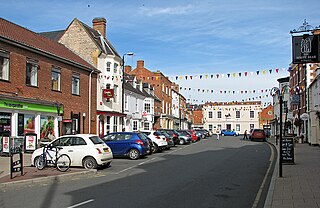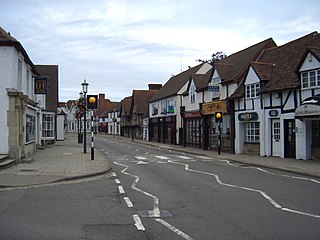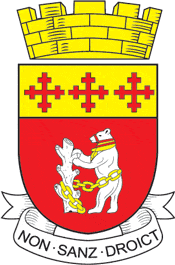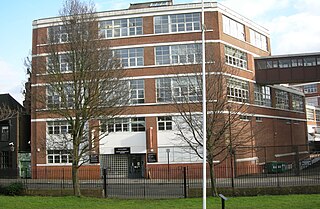Warwickshire County Record Office is the county record office for Warwickshire, England. Its purpose is to collect, preserve and make available archives relating to the history of the county and its people dating from the early 12th to the 21st century. It is located in the town of Warwick, and is owned and run by Warwickshire County Council.
The Record Office was first founded in 1933 when it was sited in the Shire Hall. Forty years after its founding it moved to its present site, which is a purpose-built building next to Priory Park. The building was later refurbished and extended in 2002 to 2003, with two new strongrooms and improved facilities for researchers. A new conservation workshop was also provided, in an adjacent building, which is a remaining part of the original 16th/17th house on the site that was demolished (except for this small part) in 1925.
Records in the County Record Office include parish registers for Warwickshire, local government records for the county, school records for the county, court records including quarter sessions and coroner's records and the records of the Warwickshire Constabulary. Several hospital archives are at the Record Office, including those of Warwickshire County Lunatic Asylum at Hatton and the former Warneford Hospital in Leamington Spa. The records of a few local firms can also be found, with many solicitors records and those of concerns like Eagle Engineering, Needle Industries Ltd and Stanley Brothers of Nuneaton.
A number of prominent local families also have records in the office including the Greville family (Earls of Warwick), the Feilding family (Earls of Denbigh), the Seymour family (Marquises of Hertford) and the Newdigate family of Arbury Hall.
In addition to the archive material kept by the record office, there are various other resources for researchers. These include a library of secondary sources relating to Warwickshire, newspapers, maps, photographs, microfilm copies of census returns for Warwickshire and microfilm copies of the GRO index (an index of the General Register Office's birth, marriage and death certificates).
The Warwickshire County Record Office is not the only repository holding archives relating to Warwickshire. Many of the records for certain areas of the historic county of Warwickshire are held by other record offices.
Other archives that hold records relating to the historic county of Warwickshire include:

West Midlands is a metropolitan and ceremonial county in the larger West Midlands region of England. A landlocked county, it is bordered by Staffordshire to the north and west, Worcestershire to the south, and is surrounded by Warwickshire to the east. The largest settlement is the city of Birmingham.

Royal Leamington Spa, commonly known as Leamington Spa or simply Leamington, is a spa town and civil parish in Warwickshire, England. Originally a small village called Leamington Priors, it grew into a spa town in the 18th century following the popularisation of its water which was reputed to have medicinal qualities. In the 19th century, the town experienced one of the most rapid expansions in England. It is named after the River Leam, which flows through the town.

Southam is a market town and civil parish in the Stratford-on-Avon district of Warwickshire, England. Southam is situated on the River Stowe, which flows from Napton-on-the-Hill and joins Warwickshire's River Itchen at Stoneythorpe, just outside the town.

Warwick is a market town, civil parish and the county town of Warwickshire in the Warwick District in England, adjacent to the River Avon. It is 9 miles (14 km) south of Coventry, and 19 miles (31 km) south-east of Birmingham. It is adjoined with Leamington Spa and Whitnash.

The West Midlands is one of nine official regions of England at the first level of International Territorial Level for statistical purposes. It covers the western half of the area traditionally known as the Midlands. The region consists of the counties of Herefordshire, Shropshire, Staffordshire, Warwickshire, West Midlands and Worcestershire. The region has seven cities; Birmingham, Coventry, Hereford, Lichfield, Stoke-on-Trent, Wolverhampton and Worcester.

Shipston-on-Stour is a town and civil parish in the Stratford-on-Avon District in southern Warwickshire, England. It is located on the banks of the River Stour, 9 miles (15 km) south-southeast of Stratford-upon-Avon, 10 miles north-northwest of Chipping Norton, 14 miles (22 km) south of Warwick and 14.5 miles west of Banbury. In the 2021 census, Shipston-on-Stour had a population of 5,849.

Warwickshire is a ceremonial county in the West Midlands of England. It is bordered by Staffordshire and Leicestershire to the north, Northamptonshire to the east, Oxfordshire and Gloucestershire to the south, and Worcestershire and the West Midlands county to the west. The largest settlement is Nuneaton and the county town is Warwick.

Knowle is a large village situated 3 miles (5 km) east-southeast of the town of Solihull, West Midlands, England. Knowle lies within the Arden area of the historic county boundaries of Warwickshire, and since 1974 it has been part of the Metropolitan Borough of Solihull within the West Midlands. It lies 2.5 miles from the Warwickshire border and had a recorded population of 10,678.

Warwick is a local government district of central Warwickshire in England. It borders the Borough of Rugby and Stratford-on-Avon District in Warwickshire as well as the West Midlands County. The City of Coventry is to the north and northeast, the Stratford-on-Avon District to the southwest and south, the Borough of Rugby to the east, and the Borough of Solihull to the west and northwest.

Leek Wootton is a village and former civil parish, now in the parish of Leek Wootton and Guy's Cliffe, in the Warwick district, in the county of Warwickshire, England, approximately 2 miles south of Kenilworth and 2.5 miles north of Warwick. It lies in the triangle created by Kenilworth, Warwick and Leamington Spa. In 1961 the parish had a population of 671.

This is about the history of the county Warwickshire situated in the English Midlands. Historically, bounded to the north-west by Staffordshire, by Leicestershire to the north-east, Northamptonshire to the east, Worcestershire to the west, Oxfordshire to the south and Gloucestershire to the south-west. Areas historically part of Warwickshire include Coventry, Solihull, Sutton Coldfield and much of central Birmingham including Aston and Edgbaston. These became part of the metropolitan county of West Midlands following local government re-organisation in 1974 after the passage of the Local Government Act 1972.

The London Metropolitan Archives (LMA) is the principal local government archive repository for the Greater London area, including the City of London: it is the largest county record office in the United Kingdom. It was established under its present name in 1997, having previously been known as the Greater London Record Office. It is administered and financed by the City of London Corporation.

Coventry, a city in the West Midlands, England, grew to become one of the most important cities in England during the Middle Ages due to its booming cloth and textiles trade. The city was noted for its part in the English Civil War, and later became an important industrial city during the 19th and 20th centuries, becoming the centre of the British bicycle and later motor industry. The devastating Blitz in 1940 destroyed much of the city centre, and saw its rebuilding during the 1950s and 60s. The motor industry slumped during the 1970s and 80s, and Coventry saw high unemployment. However, in the new millennium the city, along with many others saw significant urban renaissance and in 2017 it was announced that the city had been awarded the title of 2021 UK City of Culture.

The Lord Leycester Hospital is one of the best preserved examples of medieval courtyard architecture in England and is a charity supporting ex-servicemen. It is located in Warwick, England, next to the West Gate, on High Street. It is a Grade I listed building. The Hospital is a prominent and internationally famous feature of Warwick. For almost 900 years buildings have been erected and civic activity has taken place on the site, starting with the chapel built in 1126. The site was donated by the 12th Earl of Warwick in the 14th century to the United Guild of the Holy Trinity and St George. The Guild Hall, Great Hall and Master's House were constructed in the late 15th century. Over the centuries, the ancient buildings and 500 year old gardens have been admired by many famous visitors such as Charles Dickens and Oscar Wilde, by Kings and Queens, such as King George V and the Queen Mother and ordinary travellers from around the world.

Bickenhill is a village in the civil parish of Bickenhill and Marston Green, in the Metropolitan Borough of Solihull, in the West Midlands county, England, on the eastern fringe of the West Midlands conurbation. Bickenhill is also a ward and was within the historic county of Warwickshire. Birmingham Airport is also located within the civil parish.
Budbrooke is a village and civil parish in the Warwick district of Warwickshire, England. It is 3 miles west of Warwick and according to the 2001 census the parish had a population of 2,319, reducing to 1,863 at the 2011 Census. Most of the population of Budbrooke live in Hampton Magna, a housing estate built in the late 1960s, with other smaller settlements in Budbrooke Village and Hampton on the Hill.

Central Hospital was a psychiatric hospital located in Hatton, Warwickshire, England.

Scouting in West Midlands provides an overview of Scouting activities in the governmental region of the West Midlands. The largest number of Scouts and volunteer leaders in the region is linked to the Scout Association of the United Kingdom, while there is also a presence of traditional Scouting groups, such as the Baden-Powell Scouts' Association. The Scout Association administers the region through 8 Scout Counties, overseen by a regional commissioner, which follow the boundaries of the ceremonial counties they exist within. There are also a number of Scouting clubs within Universities in the region which are affiliated to the Student Scout and Guide Organisation.
Worcestershire Record Office is located in Worcester, England, as a part of Worcestershire County Council. The Worcestershire Record Office comprises three branches, two of which are located in County Hall, the third at The Hive, Worcester.

St John's House is an historic house located in Warwick, just east of the town centre, in Warwickshire, England. It is now an Education, Event and Wedding Venue operated by Heritage and Culture Warwickshire, part of Warwickshire County Council. It has a history spanning almost 900 years. To the side of the house is a small garden belonging to St John's and to the rear is the large St. Nicholas' Park. The current grade I listed building dates from around 1666, and is considered one of the most important buildings in Warwick.